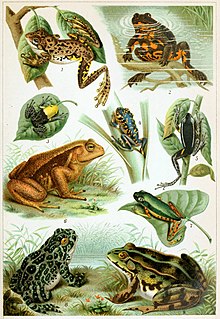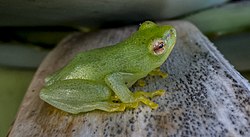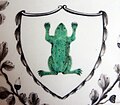Portal:Frogs
The Frogs PortalA frog is any member of a diverse and largely carnivorous group of short-bodied, tailless amphibians composing the order Anura (ἀνούρα, literally without tail in Ancient Greek). The oldest fossil "proto-frog" Triadobatrachus is known from the Early Triassic of Madagascar, but molecular clock dating suggests their split from other amphibians may extend further back to the Permian, 265 million years ago. Frogs are widely distributed, ranging from the tropics to subarctic regions, but the greatest concentration of species diversity is in tropical rainforest. Frogs account for around 88% of extant amphibian species. They are also one of the five most diverse vertebrate orders. Warty frog species tend to be called toads, but the distinction between frogs and toads is informal, not from taxonomy or evolutionary history. An adult frog has a stout body, protruding eyes, anteriorly-attached tongue, limbs folded underneath, and no tail (the tail of tailed frogs is an extension of the male cloaca). Frogs have glandular skin, with secretions ranging from distasteful to toxic. Their skin varies in colour from well-camouflaged dappled brown, grey and green to vivid patterns of bright red or yellow and black to show toxicity and ward off predators. Adult frogs live in fresh water and on dry land; some species are adapted for living underground or in trees. Frogs typically lay their eggs in water. The eggs hatch into aquatic larvae called tadpoles that have tails and internal gills. They have highly specialized rasping mouth parts suitable for herbivorous, omnivorous or planktivorous diets. The life cycle is completed when they metamorphose into adults. A few species deposit eggs on land or bypass the tadpole stage. Adult frogs generally have a carnivorous diet consisting of small invertebrates, but omnivorous species exist and a few feed on plant matter. Frog skin has a rich microbiome which is important to their health. Frogs are extremely efficient at converting what they eat into body mass. They are an important food source for predators and part of the food web dynamics of many of the world's ecosystems. The skin is semi-permeable, making them susceptible to dehydration, so they either live in moist places or have special adaptations to deal with dry habitats. Frogs produce a wide range of vocalizations, particularly in their breeding season, and exhibit many different kinds of complex behaviors to attract mates, to fend off predators and to generally survive. (Full article...) Selected article -
Frogs and toads produce a rich variety of sounds, calls, and songs during their courtship and mating rituals. The callers, usually males, make stereotyped sounds in order to advertise their location, their mating readiness and their willingness to defend their territory; listeners respond to the calls by return calling, by approach, and by going silent. These responses have been shown to be important for species recognition, mate assessment, and localization. Beginning with the pioneering experiments of Robert Capranica in the 1930s using playback techniques with normal and synthetic calls, behavioral biologists and neurobiologists have teamed up to use frogs and toads as a model system for understanding the auditory function and evolution. It is now considered an important example of the neural basis of animal behavior, because of the simplicity of the sounds, the relative ease with which neurophysiological recordings can be made from the auditory nerve, and the reliability of localization behavior. Acoustic communication is essential for the frog's survival in both territorial defense and in localization and attraction of mates. Sounds from frogs travel through the air, through water, and through the substrate. Frogs and toads largely ignore sounds that are not conspecific calls or those of predators, with only louder noises startling the animals. Even then, unless major vibration is included, they usually do not take any action unless the source has been visually identified. The neural basis of communication and audition gives insights into the science of sound applied to human communication. (Full article...)
Selected imageNeed help?Do you have a question about Frogs that you can't find the answer to? Consider asking it at the Wikipedia reference desk. General imagesThe following are images from various frog-related articles on Wikipedia.
Did you know?
TopicsQuality ContentFeatured frog and toad-related articles - Australian green tree frog - Cane toad - Common toad - Frog - Green and golden bell frog
Good frog and toad-related articles - American bullfrog - Boiling frog - Ecnomiohyla rabborum - Poison dart frog Related portalsThings you can do
Associated WikimediaThe following Wikimedia Foundation sister projects provide more on this subject:
Discover Wikipedia using portals |































































